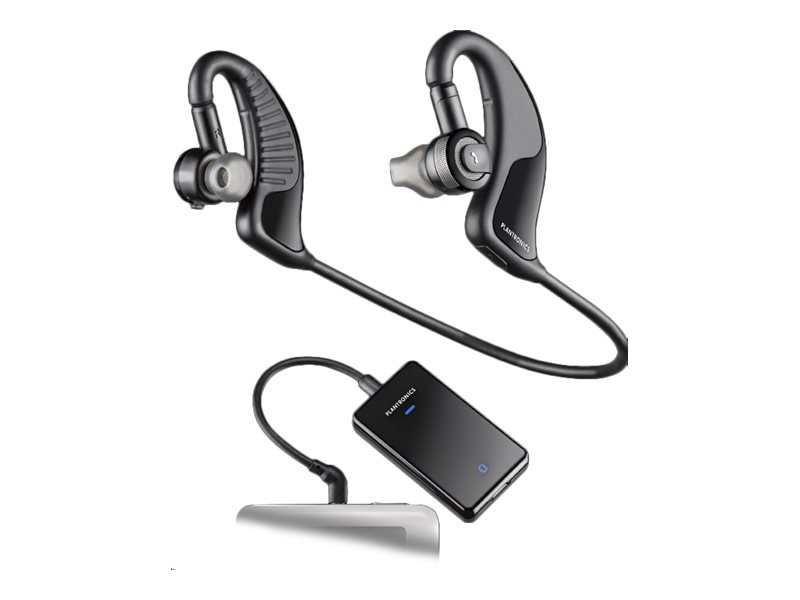
A detailed list of technical data, specifications, ratings and expert review of Poly - Plantronics Backbeat 906. Get a comprehensive look at your chosen headphones and see if these are the ones that will best suit your needs. You can also use the comparison feature to compare with other competing headphones.
design and dimensions sound quality battery and charging connections
| DESIGN AND DIMENSIONS Poly - Plantronics Backbeat 906 |
|---|
| Product Type | Headset - Bluetooth - wireless | |
|---|---|---|
| Weight | 34 g | Worse than 90 % of in-ear headphones rated. |
| Recommended Use | Portable electronics |
The Poly - Plantronics Backbeat 906 are wireless headphones that allow unrestricted movement and thus increase comfort while listening to music. Because of this feature wireless headphones are especially popular with casual users. On the other hand, the limiting factor of wireless headphones is a certain delay in sound transmission between the source and the headphones (almost indistinguishable for the average user), and they also need to be charged regularly. Unlike wired headphones, where the headphones are charged by the connected cable itself, wireless ones must be charged separately. The headphones use the Bluetooth 2.1 EDR technology for sound transmission. The weight of the headphones is 34 g.
Show more| SOUND QUALITY Poly - Plantronics Backbeat 906 |
|---|
| Headphones Form Factor | In-ear - behind-the-neck mount | |
|---|---|---|
| Connectivity Technology | Wireless | |
| Wireless Technology | Bluetooth | |
| Bluetooth Version | Bluetooth 2.1 EDR | Worse than 72 % of in-ear headphones rated. |
| Bluetooth Profiles | Hands-Free Profile (HFP), Headset Profile (HSP), Advanced Audio Distribution Profile (A2DP), Audio/Video Remote Control Profile (AVRCP) | |
| Sound Output Mode | Stereo | |
| Sound Effects | Bass Boost | |
| Frequency Response | 80 - 12000 Hz | Worse than 96 % of in-ear headphones rated. |
| Impedance | 17 Ohm | |
| Diaphragm | 14 mm | Better than 82 % of in-ear headphones rated. |
The sound quality can be affected by many factors. For many users the frequency range is a key feature of headphones. The wider the range, the more detail and nuance you will hear while listening. However, every individual perceives frequencies differently, so the frequency range of headphones varies according to individual needs. The average person perceives frequencies in the range of 16 to 20,000 Hz, so headphones with a frequency range of 20 to 20,000 Hz are most commonly available. If you are looking for headphones with a good bass performance, you should aim for lower range values (bass represents frequencies up to about 256 Hz), while high range values (frequencies roughly above 2,048 Hz) will be better for reproducing high tones. The frequency range of headphones Poly - Plantronics Backbeat 906 is 80 - 12000 Hz.
The device connected to the headphones also plays a role most times. The lower impedance value (approximately 100 to 150 Ohms) is suitable for playback from mobile phones, laptops or other portable players that do not have a powerful enough amplifier. The lower impedance will ensure that the required volume level is achieved with less power, thus extending the life of the player. However, at the same time, with lower impedance, there is more distortion of the sound. Headphones with a higher impedance of around 250 Ohms and above are then more suitable for playback from really powerful signal sources or using a headphone amplifier, otherwise the sound coming out of them might not be loud enough. At the same time, higher-impedance headphones will also ensure less distortion in the sound. In the case of these headphones, the impedance reaches the 17 Ohm value.
Headphones consist of many important parts, including the diaphragm, which is responsible for converting electrical signals into sound. The diaphragm, with a thickness of around 6 mm, is very sensitive to changes in high frequencies but less sensitive to bass. For a relatively balanced sound profile, a medium-thick diaphragm of around 10 mm is used, which can reproduce both bass and treble. A diaphragm with a thickness of around 20 mm is not as quick to respond to changes in the audio signal, and this results in poorer bass listening. However, it is very sensitive to higher frequencies. In the case of this model, the diaphragm is the 14 mm.
| BATTERY AND CHARGING Poly - Plantronics Backbeat 906 |
|---|
| Battery Type | Headset battery rechargeable - lithium polymer | |
|---|---|---|
| Battery Life | 7 hour(s) | Better than 58 % of in-ear headphones rated. |
| Standby Time | 168 hours | Worse than 60 % of in-ear headphones rated. |
In terms of headphone battery life as a significant factor in the purchase decision, it depends on what you want to use the headphones for and potentially how often you will be able to recharge them. Headphones with up to a few hours of battery life are more suitable for home use as they will require more frequent charging. Headphones with a battery life of around 10 hours or more are already more suitable for commuting and shorter journeys. However, nowadays you can also find headphones on the market that have a battery life in the higher tens to hundreds of hours. In this case, you do not have to worry about your headphones simply running out of power on longer journeys, and you will not have to deal with constant recharging. The battery life of the Poly - Plantronics Backbeat 906 reaches up to 7 hour(s).
The standby battery life quoted by the manufacturer is 168 hours.
| CONNECTIONS Poly - Plantronics Backbeat 906 |
|---|
| Connector Type | Bluetooth |
|---|
Similar Headphones
Other Plantronics Headphones